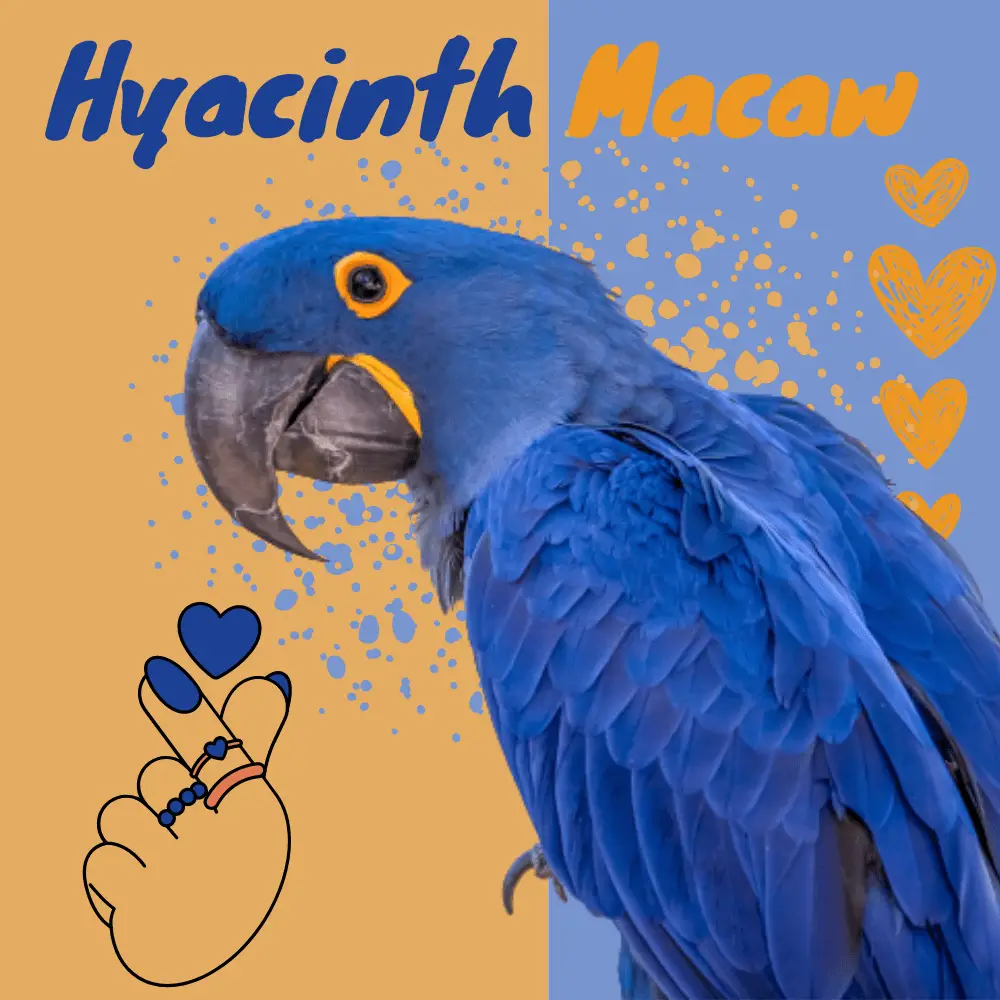
Macaw Hyacinth ( Anodorhynchus hyacinthinus ) is a parrot in the genus Blue Macaw ( Anodorhynchus ) endemic to South America. hyacinth macaw size up to 1.3 kg and a length of up to one meter, the hyacinth macaw is the largest flying parrot in the world.
The Hyacinth Macaw has been listed as Vulnerable on the IUCN Red List of Threatened Species since 2016. At that time, the population of adult hyacinth macaws was less than 4,300 animals. [2] The world’s largest population resides in the Pantanal Biosphere Reserve.
I know the impression we have the very first time we meet a Hyacinth macaw… Our imagination is racing… he’s a colossus… a giant… hell… what am I saying… a titan…, and in fact, it is actually the largest of all psittacines.
This gentle giant can measure up to 1.5 meters from head to the end of tail and Molly, my “little” female Hyacinth, despite her 1,200 gr. is considered “reduced format” with regard to the species…
So, all of what I am going to talk to you about today will always be “bigger”, “stronger” and “more destructive” than all other parrot species combined… In fact, everything becomes disproportionately huge when we speak of the Hyacinth macaw … including, of course … its price! …
Description
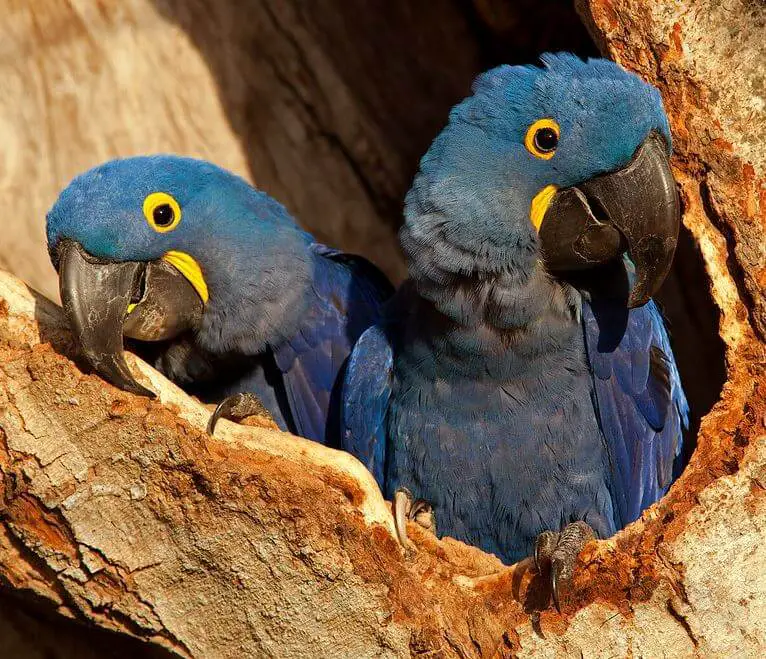
While considering the length and the size of the “bird”, it is generally this massive head provided with a disproportionate beak (of which the maxilla extends to the lower mandible ) that impresses us the most.
And what about the completely burst colors of this pleasant Goliath … this plumage of cobalt blue, shimmering purple when he rests on a beautiful sunny day, the outline of the eye as well as the hairless part of his cheeks, of a bright yellow.
And in a surge of creative impetus, on the black tongue of this bird, the deities have pushed the attention to detail to draw an equally yellow line that recalls the marking of its face …
Species
In all, there are only about 5-8 species of these very fatty nut palms appearing in its diet in its natural habitat. These nuts are extremely hard and the Hyacinth macaw has developed a very powerful bill to break the shell.
They can take up to 1,500 pounds of pressure to get there. Naturally, this specialization makes it quite difficult to feed this parrot in a North American context.
It is virtually impossible to obtain the nuts from these palms here in Canada. We must then entrench ourselves in the nuts that are available to us, such as macadamia, Brazil nuts, almonds, pecans, and coconut, which, by the way, cost a real small fortune … Another good reason to refuse to live with a Hyacinth …
On the other hand, in a domestic context, the hardest nuts we have to offer our Hyacinth are macadamia nuts which only require 325 lbs of pressure and Brazil nuts which require around 105 lbs of pressure. As well say, bite into butter for these giants! …
With about 300 pounds of pressure per square inch, the Hyacinth Macaw uses its lower mandible like a kind of chisel to snag the nut, and its upper mandible much like an anvil to hold it in place.
nuts in place. He thus manages to bite nuts that other large macaws barely manage to crack. Formidable!
Imagine the disconcerting ease with which it passes through dining room furniture !!!! Better to provide your Hyacinth macaw with hardwood toys or branches… take my word for it… it should never run out!
With the weapon of mass destruction that is the beak of the Hyacinth, I can think of at least 800 very good reasons to refuse to live with this bird …
Name
The second reason for refusing to live with this parrot is that: the Hyacinth macaw, commonly called Ara Azul in Brazil, has been given an impossible name: Oncorhynchus hyacinthinus. In fact, anodorhynchus means…
“a toothless beak”! And for good reason … we have to face the fact that the beak of this mastodon absolutely does not need teeth!
Let me explain: from a nutritional point of view, Hyacinth macaws are animals that we call “specialists”, in the sense that they are above all nut eaters.
This specialization was carried out towards a few species of palm trees producing extremely hard and above all very fatty nuts.
This is also one of the biological peculiarities of the Hyacinth macaw, it is able to ingest enormous quantities of very fatty food without developing any health problem, such as arteriosclerosis, like other species of parrots of the same. template or almost would develop for less than that.
Distribution
Adults do not reproduce until two years. So, with a replacement rate of a single baby per two years, the disappearance of nesting sites as well as palm trees, their main source of food,
Hyacinthe macaws have been found, since 1987, in Appendix 1 of CITES ( Convention on International Trade of Endangered Species of Flora and Fauna) or Washington Convention, which prohibits international trade in Hyacinth macaws captured in their environment, a species in danger of extinction.
In the late 1980s, the total population of Hyacinthe macaws was estimated to be only 2,500 to 3,000 birds. Now, thanks to conservation efforts, it is estimated that there are 6,500 Hyacinthe macaws left in the wild, of which nearly 5,000 are in the Pantanal.
But the Hyacinth macaw is still a very vulnerable species with regard to its very specific needs, both for food and for reproduction.

Thanks to the dedication of biologist Neiva Guedes who raised awareness among ranchers and landowners in the region of Brazil and Bolivia about the rapid disappearance of Hyacinth macaws, they decided to collaborate:
- by no longer tolerating smugglers or hunters on their land,
- by cutting down more certain very specific palm species, such as acuri and bocaiúva, the main sources of food for these macaws,
- allow protection organizations to install artificial nesting boxes or protect the nests of these large birds.
Hyacinth Macaw Sounds
his voice… If his rambling relates to his plumage…! Devil… this voice, not only loud and powerful… but also so different from that of other macaws… Even my African grays are unable to imitate these prehistoric and deep cries. Hearing these sounds, it seems so obvious that these birds are descended from dinosaurs… Here again, we give in the more: lower, louder, more powerful. At least 50 other reasons …
Hyacinth Macaw Breeding
The bigger it is… the more baby it is. And believe me, a Hyacinth does not evolve quickly… it remains a “baby lala” for a very long time a hyacinth… A long, long time… at least 7 years before reaching a “certain maturity” and again… Despite that Hyacinth is physically mature by the age of 5, it is usually not ready for reproduction until the age of 10. My Molly, who was 5 years old, still seems to act like a 1 year old African gray …
Hyacinth Macaw Baby
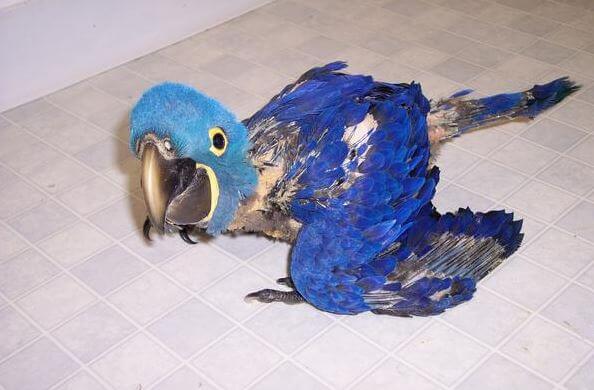
Of course, it would take too long to list all the nonsense that a juvenile Hyacinth can produce. I’ll just tell you that it’s at least fifty other good reasons to avoid this bird-like plague, some of these reasons have so far cost me, dear …
It is a bird that has the means of its size… but that one is incapable of arguing because the error is so innocent…
They say of the Hyacinth that it is a majestic bird… In its natural environment perhaps, but, between us, it loses a lot of this magnificence when it walks on the ground of our houses… let’s say that its ‘more apparent to duck under these conditions …
But, despite what reason dictates to refuse to live with a Hyacinth macaw, the happiness of sharing my daily life with Molly supplants all the logical and reasonable arguments aimed at proving me the opposite … I am a deeply unreasonable being …
I cannot end this presentation without talking to you about the darker side of the history of the Hyacinth macaw …
As you see her now, Molly is one of the animals in great danger of extinction. Indeed, competition for nesting cavities is a very limiting factor for populations of Hyacinth macaws. Again and again because of human activity, the large trees that are conducive to the formation of the large cavities necessary for the reproduction of the Hyacinth are disappearing at a phenomenal rate, as are the specific species of palm trees from which they are found. feed.
Like most large bird species, the Hyacinth Macaw reproduces very slowly in nature, usually 2 eggs of which (hopefully) at least one baby will survive, every two years or so. that the young person is completely independent.
Surprisingly, although the Hyacinth is the largest of the parrots, it does not lay the largest eggs and the latter is rather round (not the usual elliptical shape). And naturally, the young Hyacinth takes longer than the other macaws to emerge from its shell!
Young Hyacinths make their first flight around 110 days, but their feeding is still fully taken care of by the parents for about 4 to 5 months after leaving the nest, i.e. until the age of 8 to 10 months.
After leaving the nest, the young spend about 15-16 months with their parents, during which they will have to learn and assimilate the skills that will be used for their survival such as:
- the flight and its finesse,
- socialization within the social group including vocalizations,
- look for food resources and learn to prepare and eat them,
- recognize and, most importantly, avoid potential dangers.
In fact, we can say that the Hyacinthe macaws are all “Tanguy” … From the moment it comes out of the egg, the young hyacinth will spend almost 2 years with its parents before finally parting with it.
Hyacinth Macaw needs
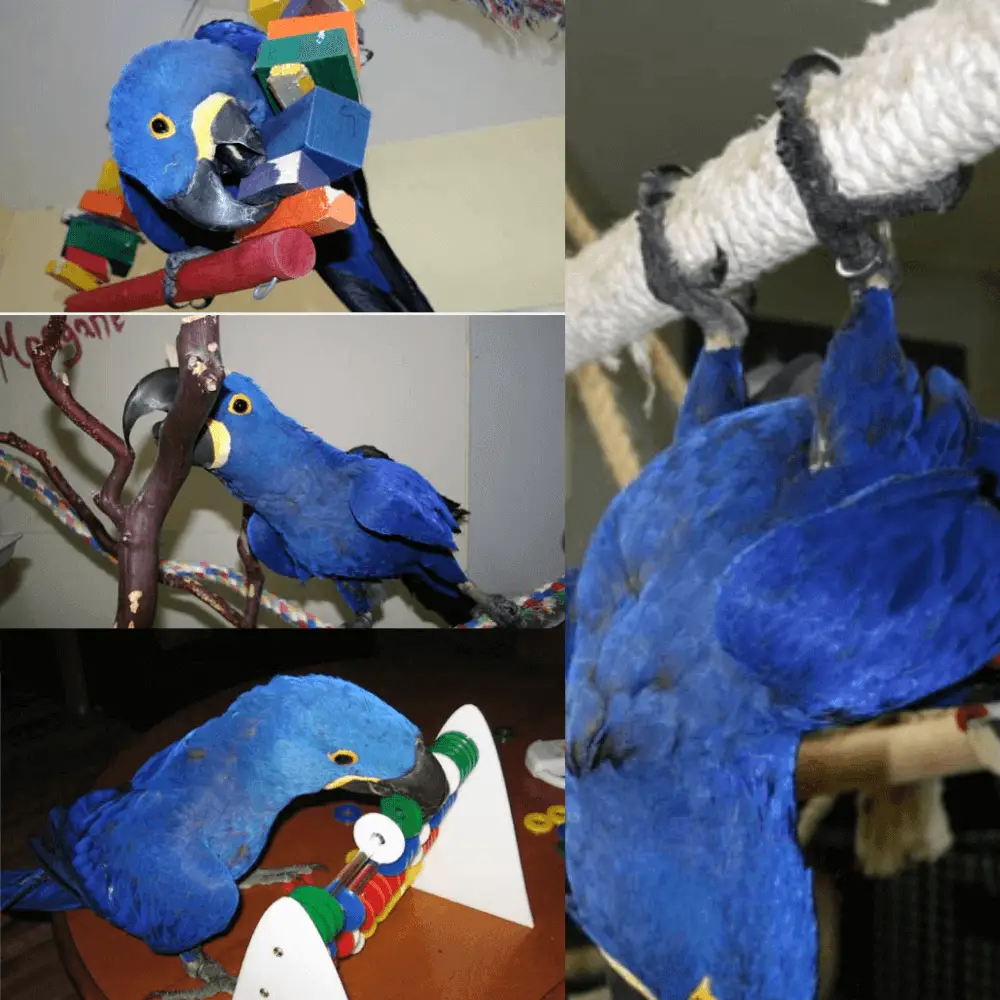
Our juggernaut also needs space … a lot of space in the house.
- Space to fly and to move a little.
- Large cage with bars of at least “pledge” 8 or even a room adapted to its stature.
- Poles adapted to the size of its legs … so as not to injure it.
- Plenty of room to set up his huge “Hyacinth” toys, as well as his gyms, ropes, poles and other trinkets that seem so obvious to all other parrot species.
- And another 50-tonne of reasons lying around the house …
Hyacinth Macaw Diet
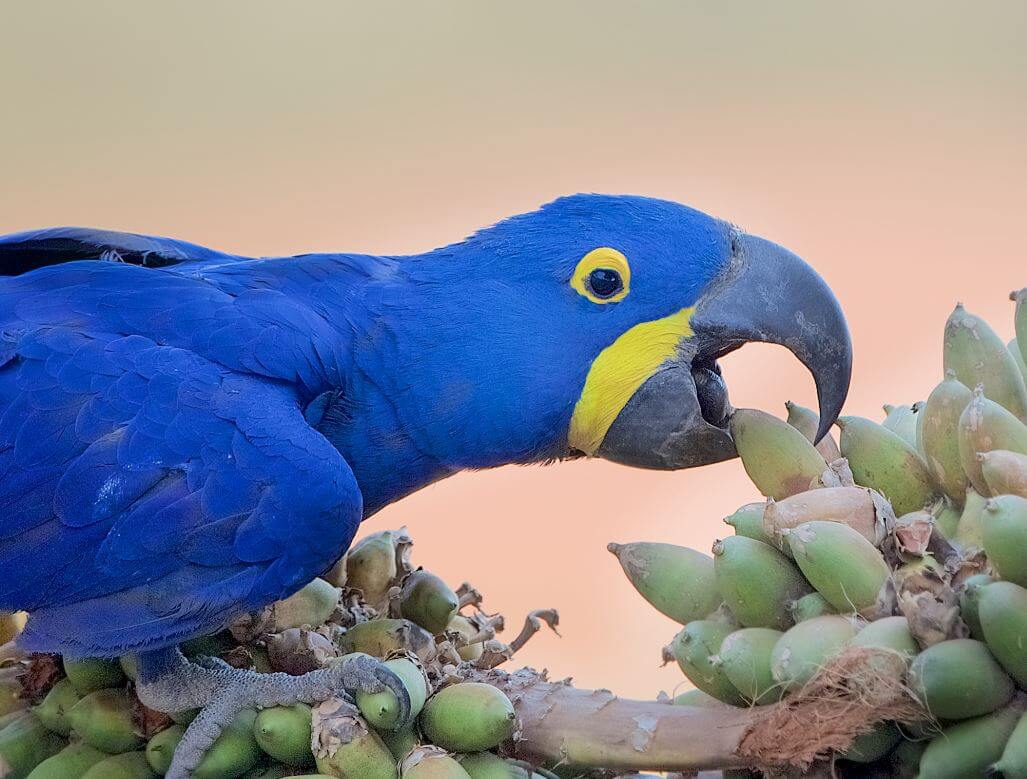
As food specialists, Hyacinth Macaws feed almost exclusively on the hard seeds of some endemic palm trees, such as Attalea and the Macauba palm.
These are easily cracked with the help of a strong beak. The Hyacinth Macaw picks fallen fruits and nuts from the ground, but it feeds mainly on trees. It searches for food in the morning and evening hours.
Hyacinth Macaw lifespan
The average lifespan of a Hyacinth Macaw is between 30 and 60 years.
Hyacinth Macaw Price
Indeed, the price of the Hyacinth macaw always remains very high and, given its rarity, the species is not likely to devalue. So, right from the start, the price certainly becomes the first reason to refuse to acquire this species of parrot, unless of course, to take a second mortgage on his house!
This breathtaking beauty combined with the legendary cuteness of this parrot makes it a truly charming and above all, irresistible bird… but… Yes, yes, there is a but… In fact, there are several…
For more information on other types of macaw:
- Blue And Gold Macaw
- Green wing Macaw
- Catalina macaw
- Red fronted macaw
- Red and green macaw
- Yellow collared macaw
- Military Macaw
- Spix’s macaw
- Blue throated macaw
- Indigo Macaw
- Scarlet macaw




















